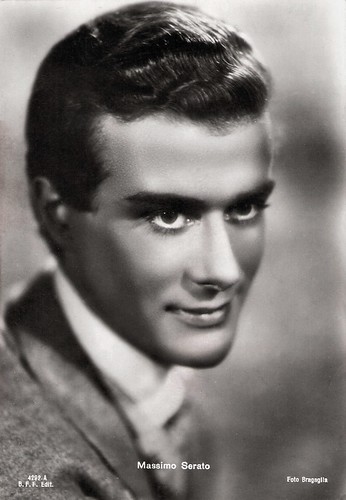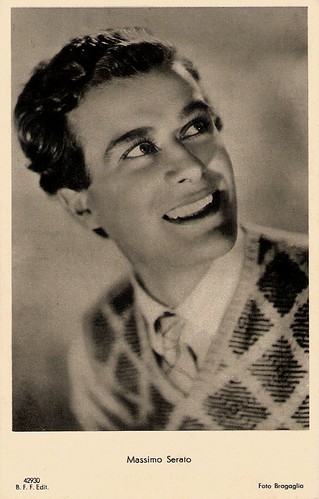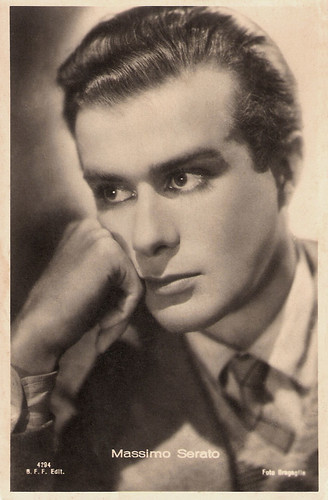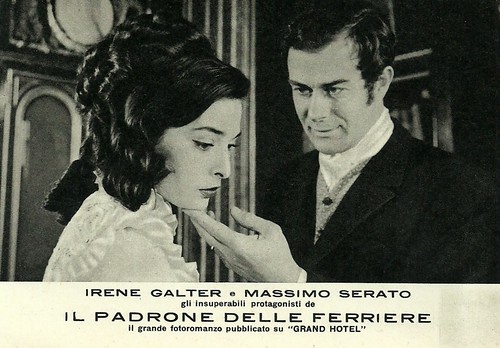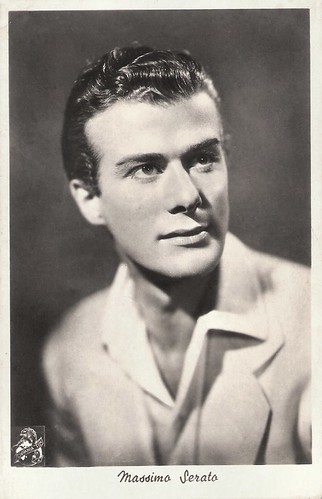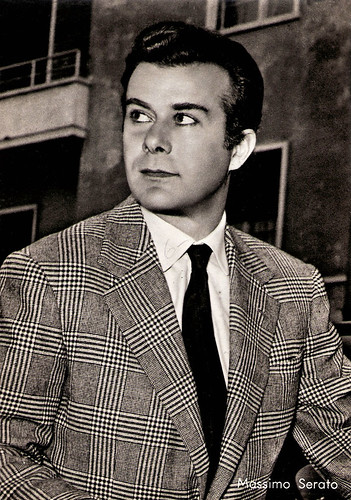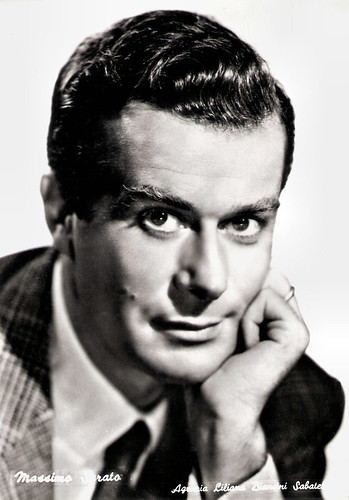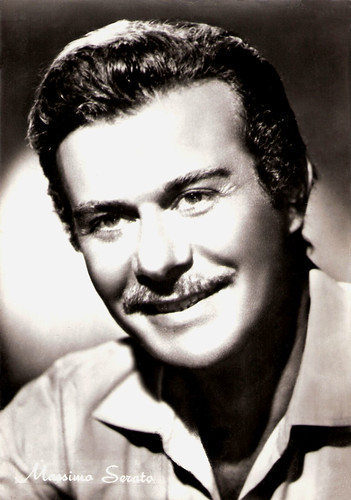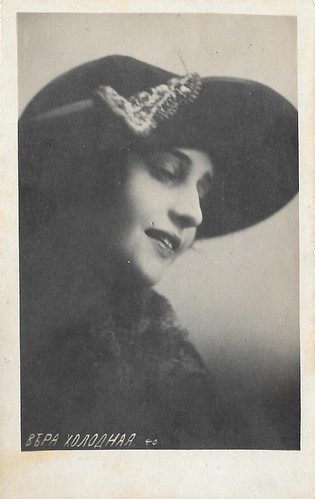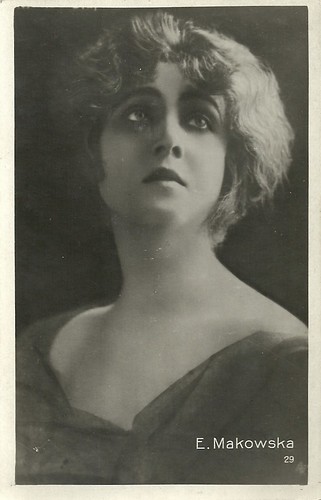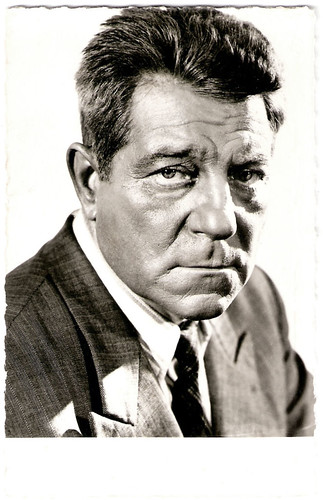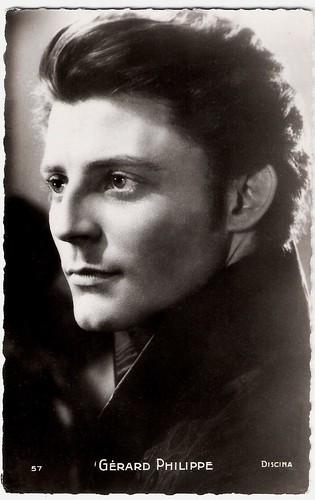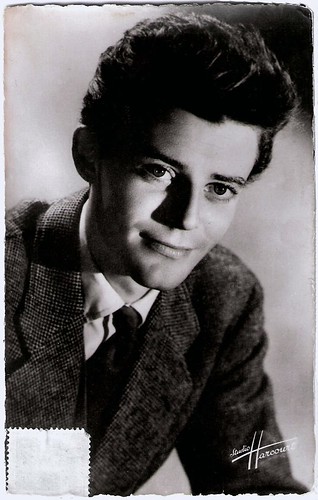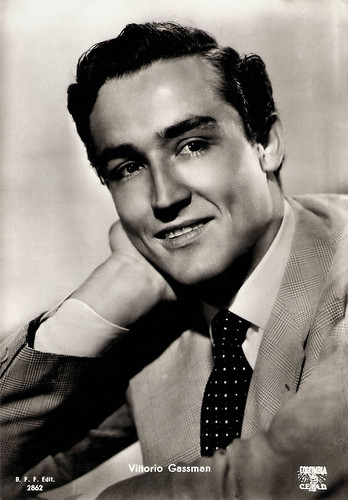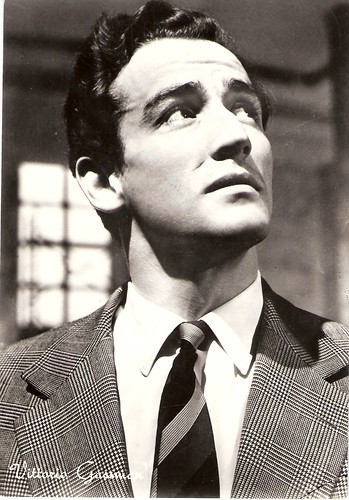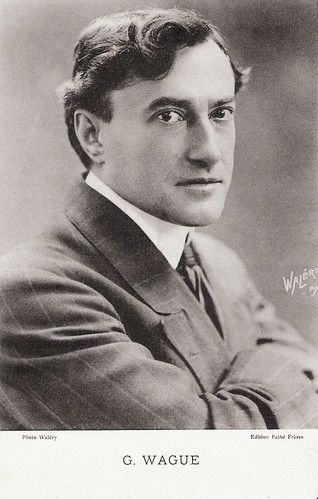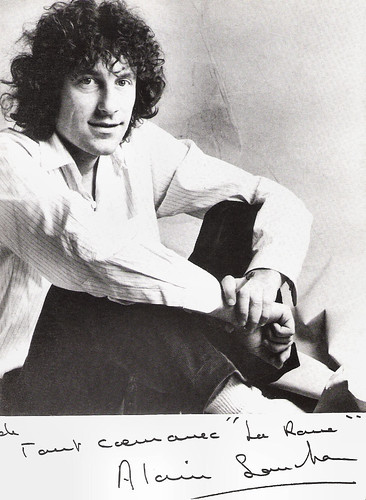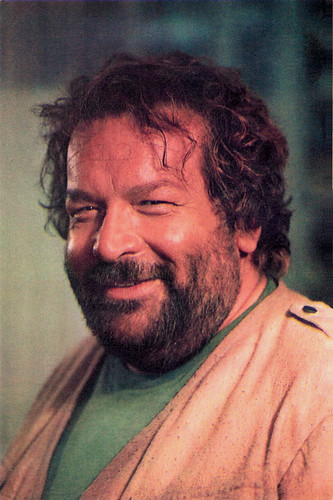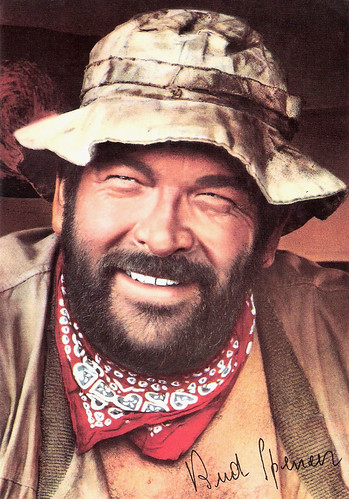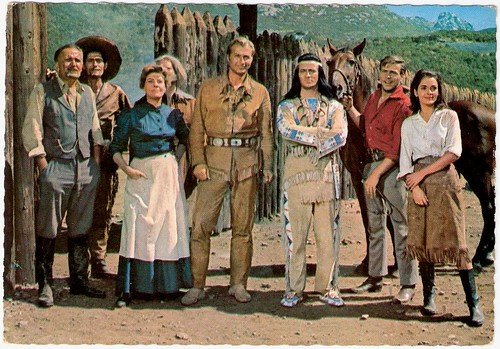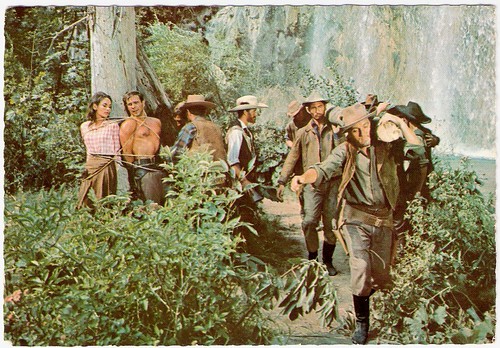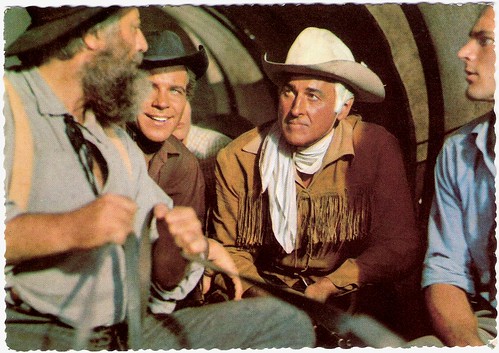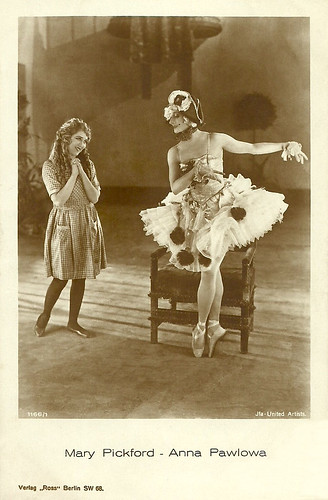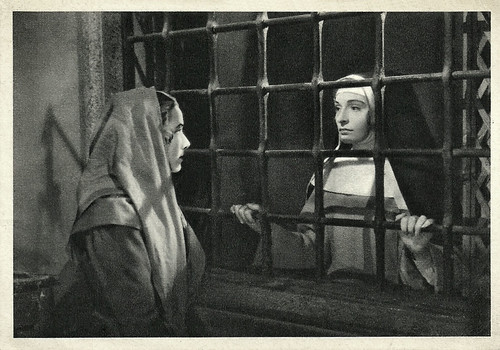Today a film special on one of the highlights of Cinema Ritrovata 2016, Madame Tallien/Madame Guillotine (Mario Caserini, Enrico Guazzoni, 1916), featuring diva Lyda Borelli. This Italian historical drama, set during the French revolution is part of the section ITALIA 1916: WOMEN AND WAR.
![Madame Tallien]()
Italian postcard by IPA CT Duplex / Uff. Rev. St. Terni, no. 3271. Photo: Film Cines. Publicity still for Madame Tallien (Mario Caserini, Enrico Guazzoni, 1916), starring Lyda Borellias Teresia Cabarus/Madame Tallien and Amleto Novellias Tallien. Caption: The release of the prisoners and Tallien.
![Madame Tallien]()
Italian postcard by IPA CT Duplex / Uff. Rev. St. Terni, no. 3272. Photo: Film Cines. Renzo Fabiani as Robespierre and Amleto Novelli as Tallien in Madame Tallien (Mario Caserini, Enrico Guazzoni, 1916). Caption: In café Venus in Paris, Robespierre communicates to Tallien who is his benefited conspirer from Bordeaux.
![Madame Tallien]()
Italian postcard by IPA CT Duplex / Uff. Rev. St. Terni, no. 3274. Photo: Film Cines. Lyda Borelli as Teresia Cabarus/Madame Tallien and Amleto Novelli as Tallien in Madame Tallien (Mario Caserini, Enrico Guazzoni, 1916). Caption: The beautiful Teresia, terribly compromised, is saved by the burning love of Tallien who invited her to represent the personage of the 'Goddess of Reason' at the party.
Madame Tallien (Mario Caserini, Enrico Guazzoni, 1916) is an Italian production by Cines, based on the French play of the same name by Victorien Sardou.
Lyda Borelli stars as Marchioness Teresia Cabarus (in the play called Thérèse de Fontenay), who divorces her adulterous husband (Ettore Barcani) in order to marry young monarchist journalist Jean Guery (Ruggero Barni), but the French Revolution prevents this.
Teresia hides Guery in her house and when the French police searches her house, she pretends he is her husband, returned from the States. Teresia seduces Tallien (Amleto Novelli), member of the Comité au Salut Public, to calm the situation. She acts in public as The Goddess of Reason and becomes a success, enabling her to save many aristocratic head from the guillotine and conspiring with the royalists.
However when Teresia rejects Robespierre (Renzo Fabiani), she puts her life and that of Tallien at risk. The conspirators are arrested and Tallien cannot save Teresia. While the others, including her own husband and Guery, are brought the guillotine, Thérèse remains in prison and meets Tallien who promises to put an end to Robespierre if she becomes his. She agrees heartbroken.
In a heated session at the Convention Tallien attacks Robespierre, who is wounded, arrested and killed at the guillotine, as he had done with so many others before him. Guery is saved from beheading in the nick of time. Thérèse is liberated and knowing that Guery is safe she keeps her promise and becomes Madame Tallien. As a hero she is carried through the city.
![Madame Tallien]()
Italian postcard by IPA CT Duplex / Uff. Rev. St. Terni, no. 3275. Photo: Film Cines. Lyda Borelli as Teresia Cabarus/Madame Tallien, and Amleto Novelli as Tallien in Madame Tallien (Mario Caserini, Enrico Guazzoni, 1916). Caption: Teresia Cabarus gets a passport for Guery from the infatuated Tallien.
![Madame Tallien]()
Italian postcard by IPA CT Duplex / Uff. Rev. St. Terni, no. 3276. Photo: Film Cines. Renzo Fabiani as Robespierre in Madame Tallien (Mario Caserini, Enrico Guazzoni, 1916). Caption: Sergeant Meda injures Robespierre.
During production a catastrophe occurred, when a footboard collapsed because of the weight of all the extras on it and one extra was killed.
Madame Tallien premiered in Rome on 18 November 1916. It was praised in the Italian press for the realism in depicting scenes from the French Revolution, in particular the scene in the Convention in which Tallien knows to change the pro-Robespierre mood in anti-Robespierre-mood, the start of Robespierre's downfall.
There was also praise for the performances of Lyda Borelli and the male actors Amleto Novelli, Renzo Fabiani and Ruggero Barni.
In Great Britain, the film was originally released in 1917 as Robespierre In 1924 the film was rereleased as Madame Guillotine. The British journal The Bioscope again praised the performances and certain scenes such as the parade with Therese as Goddess of Reason and the scene in the convention.
One of our sources, film historian Vittorio Martinelli mentions in his study Il cinema muto italiano, 1916, II a negative ending with Guery and Tallien killed and Thérèse all alone. This is not the version you can watch on YouTube. I am curious which version we will see at Cinema Ritrovata in Bologna.
![Madame Tallien]()
Italian postcard by IPA CT Duplex / Uff. Rev. St. Terni, no. 3277. Photo: Film Cines. Lyda Borellias Teresia Cabarus/Madame Tallien, and Amleto Novelli as Tallien in Madame Tallien (Mario Caserini, Enrico Guazzoni, 1916). Caption: Teresia with friends in complete oblivion of the terrible moment that drew nigh, were dedicated to the pastoral snobbishness then fashionable.
![Madame Tallien]()
Italian postcard by IPA CT Duplex / Uff. Rev. St. Terni, no. 3279. Photo: Film Cines. Ruggero Barni as Jean Guery in the silent film Madame Tallien (Mario Caserini, Enrico Guazzoni, 1916). Caption: The last cart. Guery is saved.
Madame Tallien (1916). Source: JOEPINO LANANNA (YouTube).
Sources: Source: Vittorio Martinelli (Il cinema muto italiano, 1916, II - Italian), Wikipedia and IMDb.

Italian postcard by IPA CT Duplex / Uff. Rev. St. Terni, no. 3271. Photo: Film Cines. Publicity still for Madame Tallien (Mario Caserini, Enrico Guazzoni, 1916), starring Lyda Borellias Teresia Cabarus/Madame Tallien and Amleto Novellias Tallien. Caption: The release of the prisoners and Tallien.
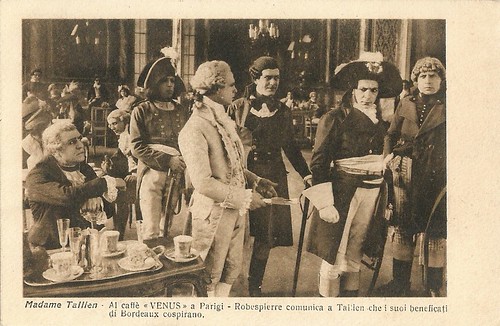
Italian postcard by IPA CT Duplex / Uff. Rev. St. Terni, no. 3272. Photo: Film Cines. Renzo Fabiani as Robespierre and Amleto Novelli as Tallien in Madame Tallien (Mario Caserini, Enrico Guazzoni, 1916). Caption: In café Venus in Paris, Robespierre communicates to Tallien who is his benefited conspirer from Bordeaux.

Italian postcard by IPA CT Duplex / Uff. Rev. St. Terni, no. 3274. Photo: Film Cines. Lyda Borelli as Teresia Cabarus/Madame Tallien and Amleto Novelli as Tallien in Madame Tallien (Mario Caserini, Enrico Guazzoni, 1916). Caption: The beautiful Teresia, terribly compromised, is saved by the burning love of Tallien who invited her to represent the personage of the 'Goddess of Reason' at the party.
The Goddess of Reason
Madame Tallien (Mario Caserini, Enrico Guazzoni, 1916) is an Italian production by Cines, based on the French play of the same name by Victorien Sardou.
Lyda Borelli stars as Marchioness Teresia Cabarus (in the play called Thérèse de Fontenay), who divorces her adulterous husband (Ettore Barcani) in order to marry young monarchist journalist Jean Guery (Ruggero Barni), but the French Revolution prevents this.
Teresia hides Guery in her house and when the French police searches her house, she pretends he is her husband, returned from the States. Teresia seduces Tallien (Amleto Novelli), member of the Comité au Salut Public, to calm the situation. She acts in public as The Goddess of Reason and becomes a success, enabling her to save many aristocratic head from the guillotine and conspiring with the royalists.
However when Teresia rejects Robespierre (Renzo Fabiani), she puts her life and that of Tallien at risk. The conspirators are arrested and Tallien cannot save Teresia. While the others, including her own husband and Guery, are brought the guillotine, Thérèse remains in prison and meets Tallien who promises to put an end to Robespierre if she becomes his. She agrees heartbroken.
In a heated session at the Convention Tallien attacks Robespierre, who is wounded, arrested and killed at the guillotine, as he had done with so many others before him. Guery is saved from beheading in the nick of time. Thérèse is liberated and knowing that Guery is safe she keeps her promise and becomes Madame Tallien. As a hero she is carried through the city.

Italian postcard by IPA CT Duplex / Uff. Rev. St. Terni, no. 3275. Photo: Film Cines. Lyda Borelli as Teresia Cabarus/Madame Tallien, and Amleto Novelli as Tallien in Madame Tallien (Mario Caserini, Enrico Guazzoni, 1916). Caption: Teresia Cabarus gets a passport for Guery from the infatuated Tallien.

Italian postcard by IPA CT Duplex / Uff. Rev. St. Terni, no. 3276. Photo: Film Cines. Renzo Fabiani as Robespierre in Madame Tallien (Mario Caserini, Enrico Guazzoni, 1916). Caption: Sergeant Meda injures Robespierre.
Catastrophe
During production a catastrophe occurred, when a footboard collapsed because of the weight of all the extras on it and one extra was killed.
Madame Tallien premiered in Rome on 18 November 1916. It was praised in the Italian press for the realism in depicting scenes from the French Revolution, in particular the scene in the Convention in which Tallien knows to change the pro-Robespierre mood in anti-Robespierre-mood, the start of Robespierre's downfall.
There was also praise for the performances of Lyda Borelli and the male actors Amleto Novelli, Renzo Fabiani and Ruggero Barni.
In Great Britain, the film was originally released in 1917 as Robespierre In 1924 the film was rereleased as Madame Guillotine. The British journal The Bioscope again praised the performances and certain scenes such as the parade with Therese as Goddess of Reason and the scene in the convention.
One of our sources, film historian Vittorio Martinelli mentions in his study Il cinema muto italiano, 1916, II a negative ending with Guery and Tallien killed and Thérèse all alone. This is not the version you can watch on YouTube. I am curious which version we will see at Cinema Ritrovata in Bologna.

Italian postcard by IPA CT Duplex / Uff. Rev. St. Terni, no. 3277. Photo: Film Cines. Lyda Borellias Teresia Cabarus/Madame Tallien, and Amleto Novelli as Tallien in Madame Tallien (Mario Caserini, Enrico Guazzoni, 1916). Caption: Teresia with friends in complete oblivion of the terrible moment that drew nigh, were dedicated to the pastoral snobbishness then fashionable.
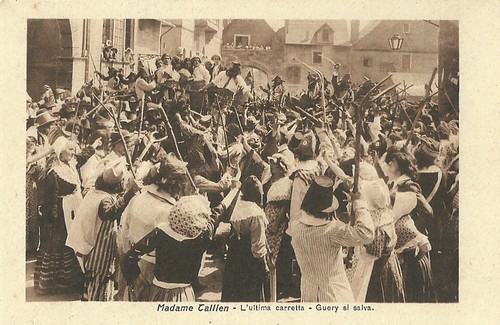
Italian postcard by IPA CT Duplex / Uff. Rev. St. Terni, no. 3279. Photo: Film Cines. Ruggero Barni as Jean Guery in the silent film Madame Tallien (Mario Caserini, Enrico Guazzoni, 1916). Caption: The last cart. Guery is saved.
Madame Tallien (1916). Source: JOEPINO LANANNA (YouTube).
Sources: Source: Vittorio Martinelli (Il cinema muto italiano, 1916, II - Italian), Wikipedia and IMDb.
